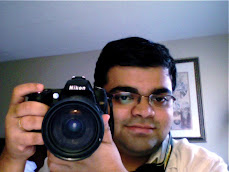Lots has been written about how it feels to have the privilege of graduating from ISB. To me, the best part of the one year was about getting to know a highly talented group of people. The first that I'd like to mention is the creative team of Reetu and Pruthvi and their brilliant cartoon series called The Cold Call.
 I have gone on record multiple times that I am a "big fan" of this strip, and I hope to see the their brand grow in value. I vouch so much on their talent that I will treasure their autographed first-issue.
I have gone on record multiple times that I am a "big fan" of this strip, and I hope to see the their brand grow in value. I vouch so much on their talent that I will treasure their autographed first-issue.
I knew I must be one of their biggest fans, but never knew that I am considered so big a fan that I get a special mention in their FAQ section, which brings me to this blog post.
Do you want to know why peacocks don't have legs? It's a long story... read it right here...
I don't remember the exact date, well it doesn't matter. It was a very fine day. On that particularly fine day, peacocks in the campus tried to imitate dance moves of a certain macro-economics professor, which resulted in irreparable damage to their legs (peacock anatomy is obviously quite different from that of professors') and so, rather unfortunately, their legs had to be amputated.
Just the way humans sell kidneys, peacocks ended up selling their legs, for cheap (read free). Peacock legs are considered a delicacy and the peacocks didn't know that. But Pruthvi and Reetu knew it and wanted to make money. They made an offer to the peacocks to dispose off their rotting legs for free and the poor peacocks were gullible enough to agree. But when so many peacock legs flooded the market (after all, the product was highly perishable), prices plummeted (just the way it happened for students at a premium b-school). Pruthvi and Reetu ended up in huge losses. Their idea of avoiding bankruptcy was to publish a book of their scribblings, which, because of smart marketing tactics, became a rage in the community.
People from the community were used to buying egg puffs for a whopping Rs. 18 each and so they didn't even blink an eyelid when buying the book for a premium. Goes without saying that the books sold like hot-cakes and the unscrupulous duo were back in business.
So, why is it written in the book that people should ask ME about the missing legs? Because I filed a 'peacock interest litigation' against Prithvi and Reetu for trying to make undue profits without any concern to the plight of the peacocks who were left handicapped. The fight was bitter and we settled out of court. Apart from the huge sum of money that I earned (because the peacocks didn't want any) and ended up donating (on the duo's behalf - see, I am ethical) to the wild-life fund, I was offered a special mention in their book, which I gladly accepted.
It's not enough if you read this tale and say "aah" and forget about it. Leave a note on the Cold Call's page. I love their work and I'm sure you do too. If you still do not know what their book is all about, God save your soul.



